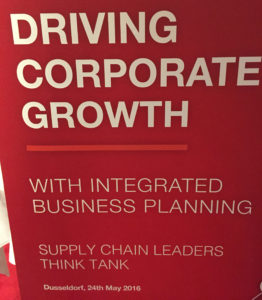 On May 24, 2016 a select group European supply chain leaders gathered together in Düsseldorf to discuss the pressing issues surrounding the topic of Integrated Business Planning and how the process can be used to drive business growth. This supply chain “Think Tank” was organized by Industry Dynamics and moderated by Debbie Bowen-Heaton and Liam Harrington of Oliver Wight, a thought leader in business transformation and sustainable behavioral change management. The session took place under the Chatham House Rule, which states that results of a meeting may be reported, however no direct quotes can be attributed to participants. This rule is implemented to encourage open and honest discussions. I, as a representative of the Inventory and Supply Chain Optimization Blog, was granted exclusive media access to the event.
On May 24, 2016 a select group European supply chain leaders gathered together in Düsseldorf to discuss the pressing issues surrounding the topic of Integrated Business Planning and how the process can be used to drive business growth. This supply chain “Think Tank” was organized by Industry Dynamics and moderated by Debbie Bowen-Heaton and Liam Harrington of Oliver Wight, a thought leader in business transformation and sustainable behavioral change management. The session took place under the Chatham House Rule, which states that results of a meeting may be reported, however no direct quotes can be attributed to participants. This rule is implemented to encourage open and honest discussions. I, as a representative of the Inventory and Supply Chain Optimization Blog, was granted exclusive media access to the event.
The Think Tank participants represented several industries, including apparel, oil & gas, fast moving consumer goods, pharmaceutical, chemical, plastics and construction. While all stemming from various backgrounds, one common objective could be identified amongst the participants: “How can we successfully implement Integrated Business Planning in our organizations?”
Understanding Integrated Business Planning
To create some context around the topic of Integrated Business Planning (IBP), the meeting began with a look at the evolution of the planning process. Dating back to the 1970’s, organizations focused almost exclusively on operations planning. The early 1980’s saw the integration of the sales function into the planning process to create what is now referred to as Sales and Operations Planning (S&OP). By the mid 80’s, this process evolved to include efforts to balance supply and demand along with inventory control, a concept referred to as Sales Inventory Operations Planning (SIOP). It wasn’t until the late 90’s that topics such as product and portfolio management found their way into the planning processes. Scenario planning and strategic deployment followed suit which led to 2010 and the collaborative Integrated Business Planning approach. When polled, the majority of participants found their organizations to be stuck somewhere between the mid 70’s and mid 80’s when it comes to the robustness of their business planning processes.
As demonstrated on this short trip through planning history, Integrated Business Planning did not simply appear as a new and hip buzzword, but rather is the result of an ever-evolving business planning approach. One participant summed up the concept as follows, “IBP is much more than an enterprise wide S&OP process. It is a tool to unify and focus the business and a platform for better decision making. It is also a tool for leaders to strengthen execution as well as a way to strengthen company culture.” Another member of the group added “IBP is not a decision to purchase a system, but rather a journey. It is not operated on a detail level. It is the forest, not the trees.”
The journey, which was often referenced throughout the meeting, can be seen on the graphic below. A member of the group pointed out the importance of understanding where an organization stands in terms of planning maturity, and cautioned against proposing an unrealistic leap in planning strategy. He presented an XY axis to further demonstrate his point:

With the majority of people claiming their planning processes are more in line with the left hand side of the scale, one can quickly conclude that significant effort and resources will be required to reach the end goal of successfully implementing IBP.
Performance Gaps
The lack of planning integration across organizational functions, as experienced by many participants, has led to several gaps in overall performance. In a brainstorming task, the attendees separated into two groups to discuss the top three performance gaps they were looking to address with the IBP process. The first group agreed that improvement of communication, financial scenario planning and the implementation of plan-do-check-act cycles are gaps that need to be addressed in their operations. The second group noted a need for improving the predictability of plans, reducing operating costs and closing revenue gaps as important topics that could be addressed by IBP. Other common themes included improving customer service, reducing inventory, supply planning and forecasting and financial reconciliation. Simply looking at these reported gaps, one can see that it will take the involvement of the entire organization to improve. These “gaps” represent the trees, and IBP (the forest) can be used as the guiding strategy to address these issues.
After reviewing these outputs, the group moved on to discuss the need to set the business planning ambition higher in order to not only make process improvements but transform the business.
Successful IBP implementation
The group quickly agreed that buy-in across all levels of the organization is a key factor to the successful implementation of IBP, starting with the executive board. Organizational leaders need to get excited and understand the true benefits IBP can bring. With realization at the top, IBP can be used to run the entire business more effectively, ambitions are often recalibrated and growth of 10-15% is possible.
In a second brainstorming activity, participants came up with some ideas on how to best engage the executive team in order to start, or progress, the IBP conversation within the organization. One participant, who is actually a member of an executive team, clearly stated what he would like to see in order to buy into the program: “I want to see a plan, with lead times, required investment, planned Return on Investment, and impact on current capacity.” Another interesting idea to engage executives that was discussed in the room is selling IBP as an opportunity to mobilize the organization to work toward a common goal. Furthermore, participants proposed the use of workshops to discuss various pain points within the organization and identify how IBP can be used to solve some of those problems. In the end, without the support of the executive team, IBP will not be successful within the organization. It is therefore imperative to involve them in the early stages.
However, a CEO shouting from the top of the organization that the company needs IBP is also not enough to create a sustainable IBP process. There must be a fundamental change in culture starting at the top, moving through line management and cascading down to the shop floor. A cultural change must take place. Several behaviors that will lead to success were discussed during the think tank:
- Do what you say you will do
- Establish a culture in which the truth is told – brutal honesty (especially regarding financials)
- Avoid surprises
- Work with one set of numbers
- Less is more – adding detail doesn’t always add insight
- Think like an owner
Without buy-in and a shift in culture, IBP will fail. One participant summed it up nicely: “All too often, executives fall in love with the potential results of the IBP approach but do not fall in love with the process. It is imperative to create an environment in which people fall in love with the process.” This of course requires a significant investment of time and money, but represents the only path to success.
Barriers to Success
In another discussion, participants were quick to note several barriers to success. Firstly, there will always be resistance to change. If organizations do not first clearly communicate the “why” before implementing IBP, there will be a significant amount of resistance from employees. It is important to address the question “What’s in it for me?” across all functions and levels in the organization and recruit change agents that will drive the desired adjustments through the organization.
Another barrier to success identified by a member of the group is misguided incentives. All too often the concept of under-promising and over-delivering is engrained in a company culture. Workers are rewarded for reaching specific financial targets that are short-sighted or only relevant for one silo of the business, which can lead to the bending of the truth when it comes time to report the results. IBP requires open and honest communication within and across the various divisions. It is therefore imperative to encourage open and truthful conversations, especially when it comes to financials. One way to do this, as proposed by a participant, is to stop the “interrogation” type reporting meetings and allow employees to first report their results and address any reconciliation needs at the end of the meeting
Additional barriers discussed in the think tank included not obtaining the required buy-in, trying to do too much at once, and not providing a clear understanding of IBP to employees and the executive team.
Conclusion
In the end, the majority of participants stood behind the idea that IBP can help transform a business, but they also agreed that this will not happen overnight. In fact, it is a process that may require several months of planning and investment before the first return can be realized.
Members from Oliver Wight will be present at this year’s Supply Chain and Logistics Summit and Expo in Barcelona and plan to continue the discussion on Integrated Business Planning. This is also an event organized by Industry Dynamics and takes place from June 20 – June 22.

